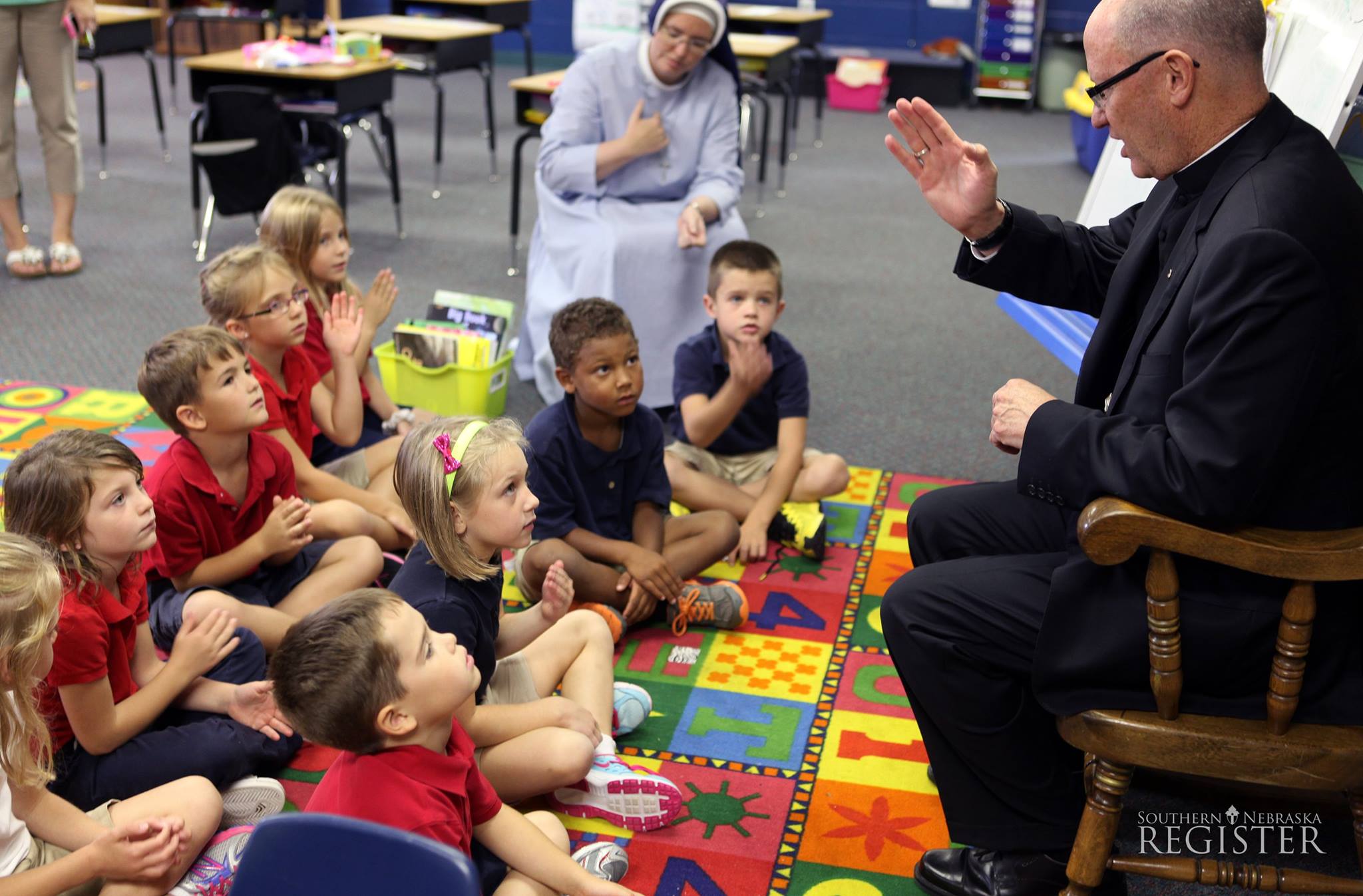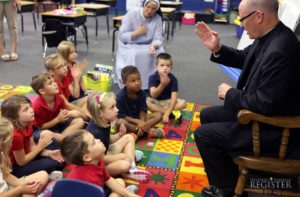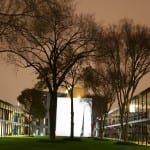Bishop Conley Reflects on Land O’Lakes and Catholic Liberal Education

Bishop Conley is the Bishop of Lincoln, Neb. A version of these remarks was offered at the Institute for Catholic Liberal Education’s Regional Catholic Classical Schools Conference on July 5, 2017, in Denver, Colo.
Fifty years ago this month, in July of 1967, a group Catholic university presidents and administrators met together at a retreat center in Land O’Lakes, Wisconsin, in Wisconsin’s northern forest, along the border with the upper peninsula of Michigan. There were 26, invited by Father Theodore Hesburgh, then the president of Notre Dame, gathered to discuss the future of Catholic higher education in the United States.
Their gathering represented the North American summit for the International Federation of Catholic Universities, which was working to develop a vision for Catholic higher education that responded to the teaching of the Second Vatican Council, Gravissimum Educationis.
What happened at Land O’Lakes is well known to many of you. In the decades prior to 1967, a movement to distance Catholic higher education from the Church’s hierarchy had been fomenting in Catholic colleges and universities across the country. Universities had begun the process of  separating themselves from their sponsoring dioceses and religious institutes. Theology faculties increasingly stepped out from orthodox Catholic positions. Catholics, in those decades before 1967, had begun playing an increasingly prominent role in American public life, and, in so doing, were becoming, little by little, more identifiably American, and less identifiably Catholic. In certain circles, Catholic intellectuals and academics had become more eager to be identified as sophisticated members of modernity, and to play down those elements of faith which were out of step with prevailing American culture.
separating themselves from their sponsoring dioceses and religious institutes. Theology faculties increasingly stepped out from orthodox Catholic positions. Catholics, in those decades before 1967, had begun playing an increasingly prominent role in American public life, and, in so doing, were becoming, little by little, more identifiably American, and less identifiably Catholic. In certain circles, Catholic intellectuals and academics had become more eager to be identified as sophisticated members of modernity, and to play down those elements of faith which were out of step with prevailing American culture.
The Land O’Lakes gathering was the culmination of that movement. On July 23, 1967, the administrators, bishops, and university presidents gathered in Wisconsin signed a “Statement on the Nature of the Contemporary Catholic University.” In their statement, they committed their universities to “contemporary and experimental” liturgy, to avoiding “theological or philosophical imperialism” in favor of “creative dialogue,” and to “true autonomy and academic freedom in the face of authority of whatever kind, lay or clerical, external to the academic community itself.”
In short, the Land O’Lakes statement declared that Catholic universities would become independent from the hierarchy of the Church, from any obligation to orthodoxy, and from the authentic spirituality of the Church.
In fact, the statement did more than that. Land O’Lakes proposed that Catholic universities ought to function as the Church’s “critical reflective intelligence,” claiming to “objectively evaluate” the Church’s life and ministry, apart from the lens of faith, in order to give the Church “the benefit of continual counsel.” It seemed to bemoan the fact that Catholic universities were not asked more often how bishops should be undertaking their ministry.
The Land O’Lakes statement proposed to redefine the mission of the Catholic university. It rejected the authority of the Church, and of her doctrinal teaching. It rejected the idea that faith and reason work best in communion with one another. It prioritized the standards and culture of secular universities over the authentic mission of Catholic education. It was a statement of self-importance, and self-assertion.
The historian Philip Gleason called the Land O’Lakes statement “a declaration of independence from the hierarchy.” But in Biblical language, we might use a different term: some have said that the Land O’Lakes statement was the “non serviam” moment of many of America’s Catholic universities.
To be sure, not all Catholic universities embraced the Land O’Lakes statement. Many remained faithful to the mission of the Gospel. And many have since undergone profound and sincere renewals in faith and mission. At the same time, the Holy See has clearly asserted the essential elements of Catholic identity at the core of Catholic higher education, beginning with the 1983 Code of Canon Law, and especially in the 1990 Apostolic Constitution Ex Corde Ecclesiae by St. John Paul II. But without a doubt, the Land O’Lakes statement changed the face of Catholic universities in America, and we are only just now beginning to recover from the impact.
* * *
This is not a gathering of Catholic university administrators. This is a gathering of teachers and principals, who are committed to recovering the best liberal traditions of Catholic education. We are gathered because we believe that education exists to form human beings: not just to function in a career, but to live, freely, and beautifully, as God made them to. We believe that education frees us for the purpose of life itself, inculcating virtue, honing reason, and fostering wonder.
But I have brought up the Land O’Lakes statement because it offers us three important points for reflection.
The first is that it reminds us of the impact of education on our culture. The erosion of authentically Catholic identity at the university level has impacted every single facet of Catholic life in the United States, and every single stage of American Catholic education.
One year after the Land O’Lakes statement, Humanae Vitae was issued, and faculty members from Catholic colleges across America led an organized and public dissent, sowing mass confusion among faithful Catholics. At the same time, campus liturgy declined, priests and religious began to disappear from college campuses, campus sexual promiscuity became tolerated, or even facilitated, tuition began to climb, and, gradually, Catholic colleges and universities began to resemble, with hardly any distinction, their secular counterparts. The loss of the Catholic university as a reliable and faithful place for formation left more than one generation of Catholic adults unformed—spiritually, intellectually, and personally—to live according to the Catholic faith. What had once been our great facilitators of Catholic culture ushered in an era of diminished religious practice, wholesale lack of catechesis, and sacred liturgy bereft of beauty.
Land O’Lakes sought to make many parts of the Catholic university indistinguishable from secular counterparts. And that has impacted the entire Church in the United States.
In the early 1960s, more than 5 million students attended Catholic schools in the United States. Today, the number is just over 2 million. There are a lot of factors which contribute to that decline. But the decline of the Catholic university as a training ground for dynamic and faithful Catholic educators, and as a context in which to discern and discover vocations, has a great deal to do with the diminished place of Catholic education in the United States.
In the 50 years since the Land O’Lakes statement, secularization in Catholic universities has led to secularization in many Catholic elementary and high schools: to textbooks which do not reflect Catholic perspectives, and to teachers who have, regrettably, not been trained to think or teach from the heart and wisdom of the Church.
An entire generation of bishops, priests, religious, and lay Catholics—myself included—were formed in the wake of Land O’Lakes. And we formed another generation, which now forms another, all of us doing the best we can, but regrettably, without being exposed to much of truth, goodness, and beauty of the Church’s tradition.
Here’s the good news: If dissenting universities, actively distancing themselves from Catholic identity, can have an impact that profound on Catholic and civic culture, then faithful schools, alive in the best traditions and wisdom of the Church, and dedicated to the formation of disciples, can be an unparalleled instrument for the revitalization of Catholic culture.
If you want authentically Catholic culture, you need authentically Catholic schools. The past fifty years have taught us that. And the work being done to foster renewal in Catholic schools across the country will significantly impact the culture of the Church in the United States. You teachers and administrators have begun, in a certain sense, a ressourcement in Catholic education today: a return to the sources, history, and patrimony of tradition, and a renewal of Christian culture rooted in the formation of minds and hearts alive in Jesus Christ, alive in faith, and alive in wonder. The impact of that renewal will be astounding.
* * *
My second point for reflection is that all Catholic educators face a temptation we must be prepared for. The Land O’Lakes statement was borne of a temptation to measure the credibility, effectiveness, impact, and importance of Catholic universities according to the standards of the world. To confuse influence, sophistication, or social acceptance with virtue and fidelity. To chase after the faddish trends of the moment, instead of being grounded in perennial truth.
“The wise man builds his house upon the rock,” the Lord tells us. So does the wise teacher, and the wise administrator. We need to be careful to ensure that our schools and classrooms are grounded in an authentically Christian anthropology, an authentically Catholic metaphysic and epistemology, and an authentic commitment to the perfection of the human person, through the renewal of the mind, the will, and the imagination, through Jesus Christ.
At the same time, we cannot eschew all that is new, or modern, or useful, simply because of its novelty. We need to discern carefully between the genuinely problematic, and the merely unfamiliar. This is especially true in the area of technology. We can’t implement technological tools unreflectively, simply because they have become faddish or the expectation of parents and the educational system. But we can’t eschew technology unreflectively either. Instead, we need to become creative enough to make use of technology in a manner that supports the liberal aims of education, and respects the dignity of the human person.
Meaningfully engaging with modernity is much more difficult than either capitulating to it or rejecting it out of hand. But that difficulty is among the most important challenges for Catholic liberal education in the twenty-first century.
* * *
My third point is that the Land O’Lakes statement reminds us of the importance of humility, docility, wonder, and receptivity in education. The Land O’Lakes statement was self-assertive and self-important. And that defies an authentically Catholic view of education.
Good students, and good teachers, seek to know things as they are. To know the Lord, and to see the world in light of divine truth. True schools are communities of learners, receiving and apprehending reality, not asserting themselves, or their importance. True communities of learners are humble disciples of the truth.
Pope St. John Paul II wrote that “faced with the sacredness of life and of the human person, and before the marvels of the universe, wonder is the only appropriate attitude.” Wonder is humility before the majesty of God. Wonder tolerates no self-importance. Wonder forgets the self. Wonder seeks only to gaze at the marvelous beauty of the world, and its creator.
In 2008, Pope Benedict XVI told American educators at Catholic University of America that “every Catholic educational institution is a place to encounter the living God who in Jesus Christ reveals his transforming love and truth.”
Encountering the living God is at the heart of true and meaningful Catholic education. This means that teachers, and administrators, must first themselves be disciples of Jesus Christ. It means that prayer—silent communion with the Eucharistic Lord—is at the center of the vocation of a teacher.
To effectively foster encounters with the living God, each one of you must cultivate a deep and abiding interior relationship with the Lord, especially in the silence of prayer. “The Lord’s first language,” said St. John of the Cross, “is silence.” All missionary activity, which seeks to foster encounter with the Lord, must begin in silence, in lives of intimate prayer before the Lord. This is especially true in education, where fostering an attitude of receptivity and humility is at the heart of your mission.
If we want to cultivate an authentically Catholic and liberal school, which frees us to know the Lord, we need to cultivate a spirituality of silence, which is the sign of discipleship—most especially silence before the Lord, in adoration of the holy Eucharist.
Communion with Jesus in the presence of the Eucharist requires that we look at him and acknowledge the mystery of his presence, and that we learn to appreciate what it really means to be looked upon by him who loves us. We each desire to be known by another — and adoration of the Lord, at the heart, is the experience of being seen, known and cherished not simply by another, but by our very Creator.
The silence, and openness, concentration and presence that the Lord asks of us when we come

before him, isn’t easy. But it is transformative. A teacher who sits in silence before the Blessed Sacrament, in humility, is transformed by the Lord, and made fit to foster authentic transformation of students.
* * *
Fifty years ago, a “declaration of independence” in Catholic education transformed the Church. Today, may your humility, wonder, and dependence on the grace of God transform your schools, transform the Church, and transform hearts for Jesus Christ.
Pope Benedict XVI taught that “the dignity of education lies in fostering the true perfection and happiness of those to be educated.” I am privileged to know teachers and administrators who believe that, and live it. May each one of you “bear witness to hope. Nourish your witness with prayer. Account for the hope that characterizes your lives by living the truth which you propose to your students. Help them to know and love the One you have encountered, whose truth and goodness you have experienced with joy.”
Via the Cardinal Newman Society.




